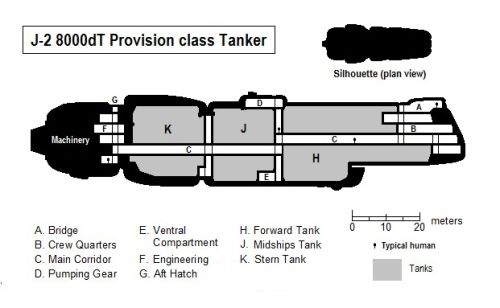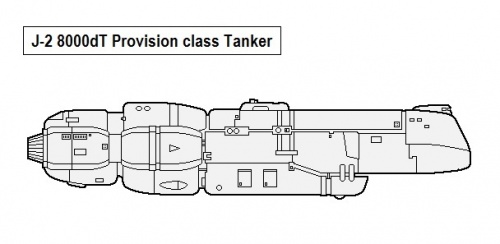Provision class Medium Tanker
| Provision class Medium Tanker | |
|---|---|
 | |
| Type: RG Gas Freighter | |
| Category | BCS |
| Size | 8,000 Tons |
| Hull Configuration | Cone Hull |
| Streamlining | Streamlined Hull |
| Tech Level | TL–11 |
| Engineering | |
| Computer | Model/4 |
| Jump | J-2 |
| Maneuver | 2 G |
| Armaments | |
| Hardpoints | |
| Accommodations | |
| Staterooms | 40 |
| Personnel | |
| Crew | 58 |
| High/Mid Passengers | 5 |
| Payload | |
| Cargo | 0 Tons |
| Fuel tank | 5,960 Tons |
| Carried craft | 1 50t lifeboat |
| Construction | |
| Construction Time | 38 Months |
| Origin | Distant Fringe |
| Price | |
| Cost | MCr3,617.144 |
| Statistics | |
| Universal Ship Profile | RG–H222241–090000–80000-0 |
| Images | |
| Blueprint | No |
| Illustration | Yes |
| Source | |
| Canon | Unpublished, fan design |
| Designer | Ade Stewart |
| Design System | High Guard |
| Era | 1105 |
| Reference | Fan: Ade Stewart |
The Provision class Medium Tanker is a TL–11 Medium Tanker.
- Please also see: Ships of the Distant Fringe
Description[edit]
A generic class of civilian vessel, the Medium Tanker is a large commercial hydrogen fuel transporter commonly encountered throughout the Distant Fringe region. It is classified as a Tanker and is constructed as a conventional design, although in all respects it qualifies as a long-range vessel. Similar designs have been in use from the time the Distant Fringe was first settled.
Image Repository[edit]
General Description[edit]
The Provision class is a streamlined flattened cone with a mean diameter of 35 meters and a length of around 125 meters. In general the vessel is wider than it is tall and the midsection is bulkier, giving it a total enclosed volume of approximately 202,500 cubic meters. Three huge fuel tanks form the majority of the interior of the ship. The tanks are separated by service decks filled with ladders and gantries and are subdivided into smaller interlinked cells containing baffles, compressors, and pumping equipment. The engineering section is located aft, within the core of the vessel, while the bridge and accessible sections of the ship such as the crew quarters and the lifeboat hangar are located forward. The main corridor, which is offset at its center to reduce the risks associated with accidents or damage, links the various decks and sections together.

A basic deck plan of the vessel indicating the general layout and positioning of major elements.
Basic Ship Characteristics[edit]
Following the Imperial Navy and IISS Universal Ship Profile and data, additional information is presented in the format shown here. The small craft factor indicates the number of squadrons (of ten craft) carried on the ship. Tonnage on the universal ship profile is shown in kilotons (thousands of tons) where necessary. [1]
| Basic Ship Characteristics [2] | ||
|---|---|---|
| No. | Category | Remarks |
| 1. | Tonnage | The Provision class is constructed using an 8,000 dTon hull built in a conical configuration. The hull is streamlined and has good atmospheric capability: its atmospheric handling characteristics are heavily reliant on its onboard gravitic systems.
|
| 2. | Crew | Total Crew Complement: 61
Accommodations
Accessible areas of the hull are fitted with grav plates and inertial compensators and have full life support and environmental systems.
|
| 3. | Performance | The vessel mounts a DeVoss-type Jump-2 drive, a Maneuver-2 drive and a Power Plant-2, giving performance of Jump-2 and 2-G acceleration and producing 160 Energy Points. The ship has an agility rating of 0 and an emergency agility of 2. The dedicated internal fuel tankage gives the power plant 4 weeks duration.
|
| 4. | Electronics | Adjacent to the bridge is a Model/4 Computer: the vessel has a backup Model/4 Computer.
|
| 5. | Hardpoints | x80 hardpoints.
|
| 6. | Armament | The normal weapons fit-out for a Medium Tanker is:
x30 triple Beam Laser turrets, forming three batteries each of 10 linked turrets |
| 7. | Defenses | The hull is unarmored.
x50 triple Sandcaster turrets, forming four batteries each of 10 linked turrets The vessel is not fitted with screens or other passive defensive systems. |
| 8. | Craft | Flight Section
The subcraft is housed in a dedicated hangar located in the bows, close to the crew accommodations: the hangar can be sealed and has a total volume of 65 dTons. |
| 9. | Fuel Treatment | The vessel has dedicated internal fuel tankage of 1,760 dTons.
The vessel has commercial fuel tankage of 4,200 dTons.
|
| 10. | Cost | The basic cost of the vessel, complete with its complement of subcraft, is MCr4,521.430
|
| 11. | Construction Time | 152 weeks (38 months) as standard.
|
| 12. | Comments | The vessel does not have a cargo hold: it is standard practice to store supplies in unused staterooms. |
History & Background[edit]
The design is representative and a large number of variants exist, particularly with regard to the allotted weapons systems, onboard electronics, and the fit out of internal spaces. Medium Tankers are designed to skim fuel from gas giant worlds and transport it back to a commercial market, using the onboard refining plant to process and purify the product en route.
Provision class ships are Gas Traders. They may work with orbital port facilities such as the Harbor class Station.
Selected Variant Types & Classes[edit]
31 Representative Tanker (RG) Classes[edit]
Civilian Ship - Freighter - Type RG Tanker
B
C
D
F
G
H
I
J
K
- KA25c Growler class Tanker
- Kandor class Tanker
- Kandor class Tanker
- Kleinnächster class Medium Tanker
L
M
N
O
P
R
T
V
References[edit]
| This article has metadata. |

|
This ship was originally designed using one of the Classic Traveller ship design rules:
|
- Author: Lord (Marquis), Captain, and Lead Naval Architect Ronald B. Kline, Jr. of the Imperial Navy
- ↑ Timothy B. Brown. Fighting Ships (Game Designers Workshop, 1981), 10.
- ↑ Timothy B. Brown. Fighting Ships (Game Designers Workshop, 1981), 10.
